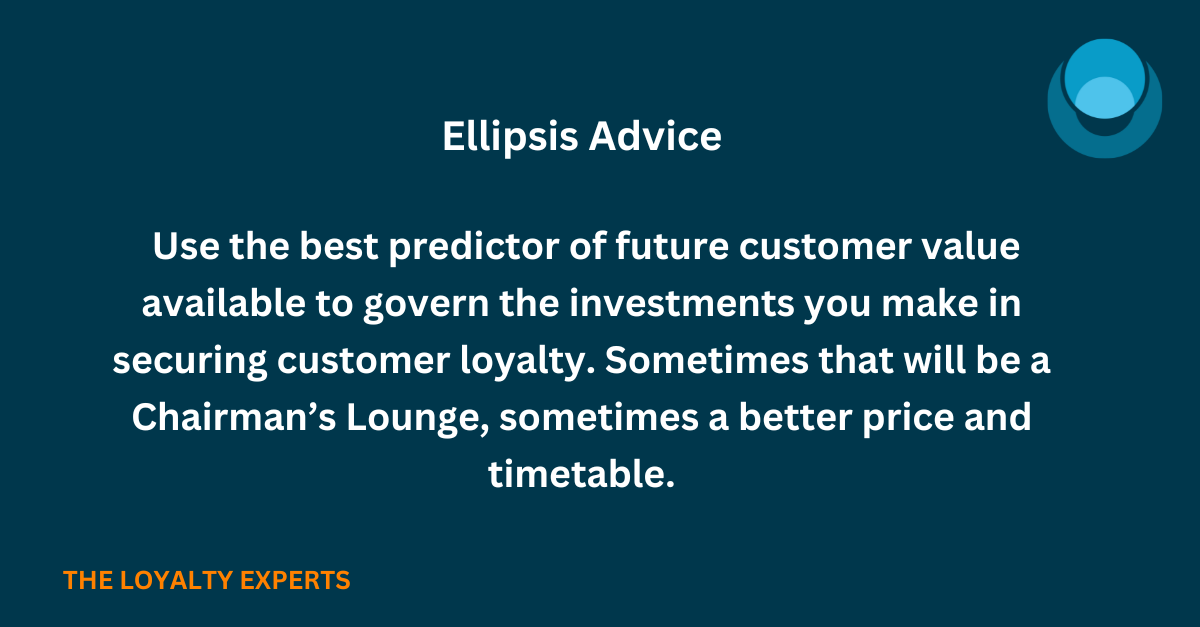
Investing Ahead of Revenue
Few marketing professionals question the traditional Loyalty Program wisdom of awarding status & benefits to the highest-spending, most valuable members. Platinum, Black Cards, and Elite tiers... are all attached to high historical spending levels.
Making the reasoning behind this practice explicit: ‘Past spending is a good predictor of future spending, so current high-value customers will continue to be heavy buyers. It is a good strategy to invest in privileges to keep them focussed on us, so we get that future revenue.’
Airline programs are masters at this; they elevate frequent and valuable customers through status tiers as they spend more, investing in them in expectation of future profit. Importantly, airline programs downgrade status in line with falling travel rates if members miss thresholds for tier requalification, demonstrating they do believe that past spending truly predicts future spending. Missing the chance to reinforce loyalty with members on the way up the tiers is as wasteful as continuing to over-invest in customers on their way down the value curve.
All ‘heavy buyers’ start as ‘light buyers’ in your program, so tiered programs should promote customers upwards in status more quickly as cumulative spending increases than they downgrade status as spending rates fall. It is better to risk a small over-spend on customers with small wallets than lose a customer with a large budget because they did not receive recognition when they initially engaged with the program.
Using historical spending volumes to predict future value works a treat unless it is an unreliable predictor of future purchasing.
Some examples where it is ‘tricky’ come to mind.
1. Infrequent high-value purchases, like luxury automobiles.
If an average buyer purchases a high-end auto every 5-8 years, starts purchasing when mid-career and buys their last car at retirement, they are in a lifetime market for seven vehicles. A customer’s historical purchases negatively correlate with their future (potential) value because the demand is fixed. You should work to sell them all seven cars of course, but do not invest as generously in customers already driving car six as you do in those buying vehicle two or three. The prize is future sales, so you invest in endowing privilege ahead of revenue. As tempting as it is to target program investment at the member who has already spent $1m, the member buying her second $80k vehicle may be a better prospect for future returns.
2. Really frequent travellers are typically high-status members of multiple airlines and hotel programs.
They choose flights based on convenience and cost and then collect the points from whichever program is involved. Spending more loyalty privilege money on them is wasteful, an entitlement that does not change their behaviour. Competitive pressure makes a withdrawal from the status battle unwise.
3. Memberships or Clubs where tenure is a badge of honour, a thing of pride.
The motor clubs in Australia are good examples; Member meetings are contests of longevity ‘I have been an NRMA/ Melbourne Football Club member for 35 years!’ Churn risk for these emotionally invested members is related to poor service or lack of recognition, not discounts or privileges.
If spending history is not a reliable guide to future purchasing value, consider adopting a more robust predictive model. A range of analytical approaches will allow you to isolate and rank the customer behaviours that are the best predictors of future purchasing, the ‘drivers of value.’ These models also include measures of their accuracy. They include a range of attributes if they have predictive relevance. For example, products purchased, inter-purchase interval, method of payment, basket size, seasonality, purchasing frequency, member age and yes, accumulated value...
“Street-lighting" is a real danger in loyalty programs, because counting the sales of a member over time is easy. If it is not a good indicator of future member value however, it is just easy, not sensible.
Undeniably, shiny high-status privileges encourage customers to enrol and engage in your program, so you need them as honeypots. But when you invest hard-earned marketing dollars in members with the objective to secure future sales and profit, use the best method of prediction available now, and that may no longer be how much they spent with us last year.
If there is a single message from this discussion, it is to use the best predictor of future customer value available to govern the investments you make in securing customer loyalty. Sometimes that will be a Chairman’s Lounge, sometimes a better price and timetable. But measure effectiveness rigorously or risk investing in the wrong places.
Willy Sutton, the American gangster, put it well – ‘I rob banks because that’s where the money is.’
We are Ellipsis, the Loyalty Experts. We help you measure, manage and grow customer loyalty. We’re here to help, please get in touch…
Download the file
Fill in the form below to gain access and download the file.